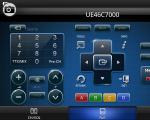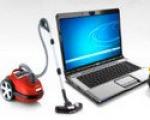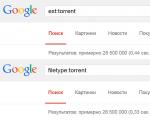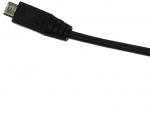Connecting a label printer to 1c accounting 2.0. Why do retail businesses need a label printer?
Automation of a trade or warehouse involves wide application barcodes for the entire range of items. However, it is not always possible to use a manufacturer's barcode. Starting from situations when there are simply no barcodes on a product to cases when the supplier’s product coding system differs from that adopted at the enterprise. To solve this problem, you will need to provide all the necessary items with your own barcodes, and a label printer will help you do this.
First of all, let's figure out what a label printer is. This is a specialized printing device that works with self-adhesive roll-type media. Printers differ among themselves in resolution, print speed and width, label roll size, etc., covering a wide range of needs, from small retail outlets to large warehouse and production complexes.
Based on the printing method, a distinction is made between thermal printing and thermal transfer printing. The first is the simplest and cheapest, you will only need thermal labels; the disadvantages traditional for this printing method are fading and darkening when exposed to elevated temperatures or direct sunlight. Thermal transfer printing requires, in addition to thermal transfer labels, a special ink ribbon, but such prints are more durable, although more expensive. The printing method should be taken into account when purchasing consumables that are practically the same in appearance, but will not work with another type of printer.
The choice of printing method depends on the type of item, expected service life and purpose of the label. If the label is intended for internal accounting purposes and does not contain the information necessary for the buyer, then it can be made extremely compact and printed on a thermal label; the same is true for goods with short term sales, for example, of products, although in this case the label may be quite detailed.
For products with a long shelf life and if the label contains information for the buyer, the thermal transfer method is recommended, especially for products exposed to bright light for a long time, such as labels for clothing or shoes. At the same time, we will refrain from making definitive recommendations, advising you to proceed from common sense and real conditions of use.
From point of view operating system and inventory accounting software, most modern label printers are no different from other printing devices, using standard printing mechanisms. This method is preferred, although some programs can work with such devices using their own languages and protocols, but this is beyond the scope of this article. But there is one significant feature: unlike “regular” printers, which are created on the “plug and print” principle, label printers require more painstaking configuration both on the part of the driver and on the part of the inventory software with which the printer will be used.
As label printers in our country, Zebra brand products, for example ZEBRA LP-2824, are well-deservedly popular, while Godex printers undeservedly remain in the shadows. I have sufficient experience working with printers of both brands; we would still recommend the Godex DT2/DT4 as an entry-level printer.

Why? Here is a small comparison table.
| Model | GODEX DT2 | ZEBRA LP-2824 |
|---|---|---|
| Printing method | Thermal printing | Thermal printing |
| Print speed | 102 mm/s | 102 mm/s |
| Permission | 203 dpi | 203 dpi |
| Label roll diameter | 127 mm (250 mm - option) | 127 mm |
| Print Width | 54 mm | 56 mm |
| Interface | RS232, USB 2.0, Ethernet | RS232, USB 1.1, LPT (optional) |
| Memory | 4 MB Flash, 16 MB SDRAM | 512 KB Flash, 125 KB SDRAM |
| Free software with database support |
GoLabel | ZebraDesigner |
| Yes | No | |
| Printer language support | Godex EZPL, Eltron, Zebra (auto switching) | Eltron, Zebra |
| Additional options | Separator, Knife (guillotine), External holder for large rolls up to 250 mm, Godex T10 - universal external label rewinder, |
Knife, Separator, External holder for large rolls, Ethernet module |
| Guarantee | Printer: 2 years Printhead: 50 km print |
Printer: 1 year Print head: no |
| Price | 230 USD | 240 USD |
As you can see, both models are almost the same both in price and in basic characteristics, however, the Godex DT2 is distinguished by the presence of a network interface, a large amount of memory and an extended warranty.

In any case, no matter what model you choose, the principle of subsequent actions will be the same. First of all, you need to find out current version firmware and update it. To do this, refer to the documentation for the printer. In general, when working with commercial equipment, make it a rule to read the instructions before starting to work with the device. This will save a lot of time and nerves.
In the case of Godex DT2, hold down the feed button (the only button on the top) and turn on the printer, wait sound signal, after which the indicator will start blinking red quickly and release the button. The printer will perform a self-test, calibrate and print model information, which will include the firmware version. We highly recommend updating it to the latest one. The printer came into our possession with firmware V1.00C and we were unable to set up normal printing from 1C on it until we updated to V1.009.
To obtain the firmware, as well as drivers and instructions, visit the website of the official representative of the brand in Russia, the Skankod company. Go to the printer page and download in the section Files latest firmware at the moment Cloud firmware V1.009, the archive with which also contains a utility for firmware.
The firmware process is quite simple, but it must be done before installing the drivers, otherwise the utility will not be able to open the port occupied by the print queue. Or use it for firmware alternative interface, for example, RS-232 if the printer is installed as USB.
Then run the utility, select the connection port and click Download Firmware specify the firmware file. The firmware will begin downloading to the device; the process will be accompanied by the progress bar filling.
 Once the firmware download is complete, the printer will begin updating it, the indicator will blink red, the frequency of blinking will increase, then after two sound signals of different tones, the indicator will turn green, indicating that the download process has been successfully completed. Then perform the self-test again and make sure that the firmware number has changed.
Once the firmware download is complete, the printer will begin updating it, the indicator will blink red, the frequency of blinking will increase, then after two sound signals of different tones, the indicator will turn green, indicating that the download process has been successfully completed. Then perform the self-test again and make sure that the firmware number has changed.
After flashing the firmware, you should download and install the drivers. This process should not cause any difficulties. Everything is extremely simple and clear. As soon as you install the drivers, the printer will appear in the standard snap-in Devices and Printers and will be accessible from any application. However, let's not rush.
First of all, we will decide on the label size, purchase and install thermal labels of the required size in the printer, after which we should perform calibration. To do this, hold down the feed button and turn on the printer. After the first sound signal, the printer begins to quickly blink red, this is a self-test mode, wait for the second sound signal and the orange indicator, then release the feed button, the printer will independently determine the label size and perform calibration. You can check this by pressing the feed button; the printer should output exactly one label.
However, the printer driver does not know anything about the label size, so we open Printing settings
 and in the section Page settings We select or create the required size of the material for printing. In our case, the labels are intended for internal purposes and a small size of 50x30 mm was chosen. We recommend giving the setting a meaningful name, for example, label size, to avoid confusion later when setting up printing from the application.
and in the section Page settings We select or create the required size of the material for printing. In our case, the labels are intended for internal purposes and a small size of 50x30 mm was chosen. We recommend giving the setting a meaningful name, for example, label size, to avoid confusion later when setting up printing from the application.

Having configured the printer, let's move on to setting up the application; in our example, we use the configuration Retail 1.0, let's open Service - Labels and price tags - Label and price tag templates. IN Template repository Let's create a new label template.

Then we'll move on to editing it, removing the standard content and creating a label with the data we need. Since the size of the label is small and its purpose is internal accounting, we placed the name of the item and the barcode there. If necessary, you can add the necessary details by simply dragging them from the left column. The built-in editor is quite convenient and allows you to easily create templates for price tags and labels of any complexity.

If you are using the configuration Trade management, then there is no built-in editor and you will have to create a label layout using Configurator, however, the meaning of subsequent actions does not change.
Having created the label, let's try to print it. Most likely, you won’t succeed the first time, so let’s look at this process in more detail. If you see the following result, when the label seems to print correctly, but is not in its place, then you should calibrate the printer.

After calibration, you should get a different result, for example, this output says that the label did not fit vertically, so it is transferred to the next physical label, and since the barcode is a solid object, it is not divided into two parts, as in the past example, but it is printed twice.
 Opening File - Options pages and changing the margin sizes and scale, we ensure that the label fits on one physical label and takes a position in the upper left corner. In our case, the settings turned out like this, please note that as the paper size you should specify the size of the material we created in the printer properties:
Opening File - Options pages and changing the margin sizes and scale, we ensure that the label fits on one physical label and takes a position in the upper left corner. In our case, the settings turned out like this, please note that as the paper size you should specify the size of the material we created in the printer properties:
 Let's check, the result should be quite decent:
Let's check, the result should be quite decent:
 Now, by changing the size of the label template, we ensure that it occupies the entire area of the media:
Now, by changing the size of the label template, we ensure that it occupies the entire area of the media:
 As you can see, nothing complicated. Ready template can be uploaded to an mxl file (or uploaded from a file to another information base) using the buttons Import/Export(circled with a dotted line). For example, we post below the 58x30 label template we used in this article.
As you can see, nothing complicated. Ready template can be uploaded to an mxl file (or uploaded from a file to another information base) using the buttons Import/Export(circled with a dotted line). For example, we post below the 58x30 label template we used in this article.
Connecting and setting up a label printer is no more difficult than a regular office printer. The engineers of the online store “Formula Commerce” talked about how to do this.
We connect the printer via USB or RS-232
Printers have two standard connectors: RS-232 and USB. Let's consider both connection options.
Connection via RS-232
The label printer, like a regular office printer, is displayed in the “Printers and Faxes” section and uses a print queue.
Connection process:
- The printer is connected to the workstation and software settings are performed.
- A label layout is created in a graphic editor or in a commodity accounting program.
- Indicate the print source: from graphic editor(it is either downloaded from the developer’s website, or it comes with the printer) or from the inventory program. (In the latter case, the layout must be created in a commodity accounting program.)
- After this, the device begins to appear in the “Printers and Faxes” section. It is either selected by default or indicated each time when printing.
- The device prints on the media that is charged into it.
- When creating a label layout, you need to set its parameters. This is necessary so that when printing the characters do not extend beyond the label. They also set the interlabel distance, tape type, print speed and quality in dpi (dots per inch).
USB connection:
- The printer is connected to the computer via USB.
- Install drivers.
- On the computer, indicate the port with the connected printer (in the software, the printer can be searched automatically).
- Any new equipment connected via USB creates a virtual port with a unique address. For example, 1, 2, 3. So, if three printers were connected to one physical port, then each of them emulates a port with its own address in the program. For example, 001, 002, 003. This is a property of the operating system.
Usually, when installing drivers, the connection occurs automatically and the printer starts working. After this, you need to configure the equipment. Most manufacturers do this through separate utilities.
Making a label layout
The graphics editor is similar to Paint. He has an intuitive clear interface, so the program is easy to work with. The desired language is selected on the panel, and the barcode and other elements are moved across the label area by highlighting the field in which they should be located and dragging them with the mouse.

Not all printers support non-standard characters. That is, for example, if you need to put text on Chinese, the necessary symbols may be in the graphic editor set. However, the printer will produce question marks instead when printing.
Information about which specific characters the device supports must be clarified in advance. A basic set of languages that all printers work with: Russian, English, German, Japanese and Korean.
Drivers
First, the software is selected, and the equipment for it is selected. You can use generic or custom drivers.
- Are common. Seagull Scientific produces drivers for all printers that are compatible with all operating systems.
- Specialized. Printer manufacturers create a driver and program to print labels.
ZL 2824 PLUS in 1C
First of all, you need to install the ZL 2824 Plus printer driver on your Personal Computer. It should be on the installation disk that came with the printer.

If the disk is not there, then you can download it from the official website by following this link https://www.zebra.com/us/en/support-downloads/desktop/lp-2824-plus.html.
Before starting the installation, make sure that the printer is not connected to the computer!
Then run the installation file.








After all the steps you have completed, the program will complete the driver installation, and you just need to connect the label printer.


If you connected the printer before installing the driver, then to do this you should click on the Manual Install button ( Manual installation) and again perform the series of steps shown below.


In this window you must select the model of your printer. In our case it is
LP 2824 Plus (ZPL).

Then you need to specify the port, that is, through which your printer is connected.

After installing the printer, you must configure the label sizes in it. To do this, go to the Zebra utility menu to select a language. Click Options\language

Then click on the "Set printer settings" button.

Enter the parameters of your labels and configure the printer.



You save everything.
Then you should install the 1C: Barcode Printing component (ActiveX).
You can download it from the website https://users.v8.1c.ru or find the ITS 1CBarCode on the disk.





After installation, go to the 1C program and start setting up the printer.
To do this, you must select a product line, find your product with a barcode in it, and click print-labels.

You must fill out all printing options. Select the label printer format, set the parameters of your label and click “Fill”.


In it you select page parameters  (Icon next to the printer).
(Icon next to the printer).
After selecting the printer, click on the “printer” button.


In the printer properties, select the paper format and label size. Then click "Ok".
Then you reset everything in the page parameters, set it to fit the page width, click “OK” and see the result.


The printer will print the barcode across the full width and height of the label.
If you are not satisfied with your result, you can try to adjust it manually. To do this, you need to go to the page settings and configure the fields as you wish. In our situation, everything looks like this.


Your printer will now print a barcode in the middle of the label.
The printer is ready to go!
In this article we will look at the issue of connecting and setting up a label printer to 1C Enterprise 8 software. Before reading this material, we recommend that you read the contents of the article “”, which discusses the issue of installing drivers and calibrating the printer for consumables of different sizes. When compiling this guide, we will assume that the printer has already been connected and calibrated. To set up a printer in 1C, you do not need special drivers or maintenance procedures; the device works on the principle of a regular printer. Printers connect to all current 1C Enterprise platforms (7.7, 8.0, 8.1, 8.2 and 8.3).
IMPORTANT! To successfully connect a printer and print labels in Trade Management 10.x and Retail 1.x configurations, the installation of 1C Components: Barcode Printing is required. To print labels in the 1C 7.7 Trade and Warehouse configuration, registration of the BARCODE.OCX component is required.
Let's look at connecting and setting up a printer using the example of the 1C Enterprise 8.3 Retail 2.0 configuration. The form for printing labels and price tags is located in the main menu “Purchases” at Service - Printing labels and price tags (Fig. 1)
(Fig.1) Printing price tags and labels
In the form that opens, you can select items that need to be sent for printing, as well as set templates and quantities of price tags and labels to be printed. In this article, we will not touch upon the issues of creating templates for labels and will use standard solutions from 1C Retail. (Fig.2)

(Fig.2) Form for printing price tags and labels
After setting all the necessary values in the “Printing labels and price tags” processing, click on the print button and display the printed form of our labels. The printed form will look the same as in (Fig. 3)

(Fig.3) Printing form
To configure the label format in the printer, click the “Preview” button on printed form, then select “Page Options”. In the window that opens, you need to select your label printer (in our case it’s a Zebra TLP2824), remove all fields and footers and assign them the value 0. The scale parameter should be set to “to page width” (Fig. 4)

(Fig.4) Page settings
After we select the printer, the media sizes specified in the driver will be automatically adjusted (in our case, this is a 58x40 label). Please note that, unlike old configurations, label sizes are set in the page parameters. The size can be absolutely any, provided that the dimensions and parameters are specified in the driver. Click the “OK” button and go to the preview. After all the settings, our label should appear like this.
write admin Published in:




Now you have a brand new printer for printing barcodes at your workplace. The only thing left is to connect it to the PC.
Often, modern barcode label printers are sold complete with drivers compatible with Windows OS and do not require any complex manipulations to set up.
1C is used for accounting and sales of goods. Most systems are based on this software product. Therefore, the barcode scanner must also be compatible with this software.
Unfortunately, 1C has become notorious for requiring the equipment to have a high-power processor and a maximum amount of RAM.
Such requests are determined by the very principle of sending print jobs for 1C.
The program perceives each barcode as a separately received task, even if you have started printing a batch of labels.
In addition, 1C requires taking into account the size of the actual printed label.
The length of the printed sample has a significant impact on the amount of resources spent by 1C to process data per unit of time.
So, let's get closer to practice!
You have connected a printing device to your computer and agreed to install the drivers (More information about the Atol input device driver can be found in the “ Software") and read the license agreement.
Regardless of the printer model you choose and the OS installed on your PC, you will need to do the following:
Go to the Windows directory in the Fonts folder and find the barcode font (zsdbarnt.ttf) there.
If it is missing, download and install. Similarly, you need to check for the presence of the barcode.ocx file.
Please note that the main problem that may prevent you from printing is setting the sticker size.
To fix this, go through the menu to Control Panel - Printers - Print Server. We're in context menu printer.
Now open the 1C: Service configuration - go to the “Users” tab. Find the line “List of users”. We move further according to the following scheme: User - Retail and commercial equipment.
Our goal is the “Printing Labels” tab.
Here, in the settings of your printing device, check the preview option. For your changes to take effect, you need to allow them to be added to the menu.
The “movement” diagram looks like this: Configuration - Support - Support settings.
Remember: the label sizes specified in 1C and for the printer must be the same (it happens that users have a label split into two Word pages- this should not happen).
If the printer settings themselves require correction, you need to get from the menu to “print server properties”. A new window will open in which you will create a new print template.
In the future, it will be available for selection when sending print jobs.
If you still weren’t able to set up the device on your own, contact our specialist.




